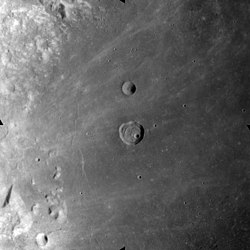 Apollo 17 mapping camera image | |
| Coordinates | 18°16′N53°21′E / 18.26°N 53.35°E |
|---|---|
| Diameter | 18.86 km (11.72 mi) |
| Depth | 1.8 km (1.1 mi) [1] |
| Colongitude | 307° at sunrise |
| Eponym | Benjamin Peirce |



Peirce is a small lunar impact crater in the western part of Mare Crisium. That dark, circular lunar mare is located in the east-northeasterly part of the Moon's near side. It was named after the American mathematician Benjamin Peirce. [2] Peirce lies to the north of the craters Yerkes and Picard, and southeast of Macrobius located outside the mare. Just over a crater diameter to the north of Peirce is the smaller Swift. To the northwest is the wrinkle ridge Dorsum Oppel.
Contents
The rim of Peirce is roughly circular, with a slight outward bulge along the northwestern rim. There are indications of slumping along the sides of this section, producing a wider inner wall. It is generally bowl-shaped, and is marked only by a tiny craterlet along the inner southeast rim. The interior is marked by several furrows, ridges, as well as a low, conical hill near the midpoint.
Peirce is a crater of Eratosthenian age. [3]